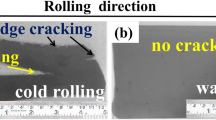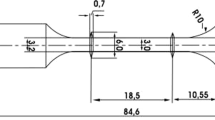Abstract
Rolling-spinning of titanium alloy tubes is an advanced plastic forming technology that has been developed due to the urgent need for light-weight, high-precision, and high-reliability components in high-tech fields, such as aviation and aerospace. However, due to the complexity of the rolling-spinning process and the sensitivity of titanium alloy to temperature and strain rate, it is easy to crack, which severely restricts the improvement of the forming quality and forming limit of components. In this study, the critical deformation of Ti-6Al-2Zr-1Mo-1V was obtained by a hot compression test under various temperatures and strain rates. The damage threshold was obtained through FE simulation for the hot compression process under these temperatures and strain rates. The relationship among damage threshold, temperature, and strain rate was established by introducing the Zener-Hollomon factor. A thermal damage model for Ti-6Al-2Zr-1Mo-1V was established by combining the Oyane ductile fracture criterion with the relationship among damage threshold, temperature, and strain rate. By coupling this thermal damage model into the FE model for rolling-spinning of a Ti-6Al-2Zr-1Mo-1V tube, the damage prediction for the process was realized. The results show that the stress triaxiality at the top and bottom ends of the rolling zone is positive, the accumulation of damage is fast, and the strain rate is large in the zone. Thus, these ends are the zones most prone to damage in rolling process. The stress triaxiality at the local inner surface area of the spinning region is positive, the accumulation of damage is fast, and the strain rate is large in the zone. Therefore, the inner surface of the spinning region is the zone most prone to damage.
Similar content being viewed by others
References
Kopp R (1996) Some current development trends in metal-forming technology. J Mater Process Technol 60:1–9
Zhu S, Yang H, Guo LG, Hu LL, Chen XQ (2014) Research on the effects of coordinate deformation on radial-axial ring rolling process by FE simulation based on in-process control. Int J Adv Manuf Technol 72(1-4):57–68
Zhan M, Yang H, Zhang JH, Xu YL, Ma F (2007) 3D FEM analysis of influence of roller feed rate on forming force and quality of cone spinning. J Mater Process Technol 187–188:486–491
Huang L, Zeng R, Zhang XT, Li JJ (2014) Study on plastic deformation behavior of hot splitting spinning of TA15 titanium alloy. Mater Des 58:465–474
Roth CC, Mohr D (2014) Effect of strain rate on ductile fracture initiation in advanced high strength steel sheets: experiment and modeling. Int J Plast 56:19–44
Liu G, Zhang GJ, Wang RH, Hu W, Sun J, Chen KH (2007) Heat treatment-modulated coupling effect of multi-scale second-phase particles on the ductile fracture of aged aluminum alloys. Acta Mater 55(1):273–284
Bhattacharjee D (1994) Ductile fracture in HY100 steel under mixed model І/model П loading. Acta Metall Mater 42(5):1747–1754
Yamamoto H (1978) Conditions for shear localization in the ductile fracture of void-containing materials. Int J Fract 14(4):163–182
Cao TS, Bobadilla C, Montmitonnet P, Bouchard PO (2015) A comparative study of three ductile damage approaches for fracture prediction in cold forming processes. J Mater Process Technol 216:385–404
Rafsanjani A, Abbasion S, Farshidianfar A, Irani N (2009) Investigation of the viscous and thermal effects on ductile fracture in sheet metal blanking process. Int J Adv Manuf Technol 45(5):459–469
Boisse P, Altan T, Luttervelt K (2003) Friction and flow stress in forming and cutting. Sterling, London
Goijaerts AM, Govaert LE (2001) Evaluation of ductile fracture model for different metals in blanking. J Mater Process Technol 110(3):312–323
Li H, Fu MW, Lu J, Yang H (2011) Ductile fracture: experiments and computations. Int J Plast 27(2):147–180
Yu S, Xie XL, Zhang J, Zhao Z (2007) Ductile fracture modeling of initiation and propagation in sheet-metal blanking processes. J Mater Process Technol 187–188:169–172
Komori K (2003) Effect of ductile fracture criteria on chevron crack formation and evolution in drawing. Int J Mech Sci 45(1):141–160
Zhan M, Gu C, Jiang ZQ (2009) Application of ductile fracture criteria in spin-forming and tube-bending processes. Comput Mater Sci 47(2):353–365
Alexandrov S, Wang PT, Roadman RE (2005) A fracture criterion of aluminum alloys in hot metal forming. J Mater Process Technol 160:257–265
Kim WJ, Kim HK, Kim WY, Han SW (2008) Temperature and strain rate effect incorporated failure criteria for sheet forming of magnesium alloys. Mater Sci Eng A 488:468–474
Kumar J, Kumar A, Kumar V (2011) Ambient and high temperature in situ damage evolution in nickel based IN718 super alloy. Mater Sci Eng A 528:4009–4013
Zhang XM, Zeng WD, Shu Y, Zhan YG, Zhao YQ, Wu H, Yu HQ (2009) Fracture criterion for predicting surface cracking of Ti40 alloy in hot forming processes. Trans Nonferr Metal Soc 19:267–271
Zhu YC, Zeng WD, Zhang FS, Zhao YQ, Zhang XM, Wang KX (2012) A new methodology for prediction of fracture initiation in hot compression of Ti40 titanium alloy. Mater Sci Eng A 553(15):112–118
Shen CW (2007) Models of TA15 and TC11 titanium alloys in hot deformation process. Dissertation, Northwestern Polytechnical University
Lin YC, Xia YC, Chen XM, Chen MS (2010) Constitutive descriptions for hot compressed 2124-T851 aluminum alloy over a wide range of temperature and strain rate. Comput Mater Sci 50(1):227–233
Rohr I, Nahme H, Thoma K (2005) Material characterization and constitutive modelling of ductile high strength steel for a wide range of strain rates. Int J Impact Eng 31(4):401–433
Hokka M, Leemet T, Shrot A, Baeker M, Kuokkala VT (2012) Characterization and numerical modeling of high strain rate mechanical behavior of Ti-15-3 alloy for machining simulations. Mater Sci Eng A 550(30):350–357
McQueen HJ, Ryan ND (2002) Constitutive analysis in hot working. Mater Sci Eng A 322(1-2):43–63
Chen FR, Huo LX, Zhang YF, Liu FJ, Chen G (2004) Three dimensional finite element numerical simulation of residual stress in BT20 titanium alloy electron beam welding. Trans Chin Weld Inst 25(1):61–64
ABAQUS. Inc (2009) ABAQUS 6.11 html documentation. ABAQUS, Inc, USA
Wang M (2011) Comparison of evolution laws of stress and strain fields in hot rolling of titanium alloy large rings with different sizes. Trans Nonferr Metal Soc 21(9):1611–1619
Li B (2010) Research on hot spinning process and microstructure evolution of AZ81. Dissertation, Chongqing University, 1-60
Author information
Authors and Affiliations
Corresponding author
Rights and permissions
About this article
Cite this article
Zhan, M., Zhang, T., Yang, H. et al. Establishment of a thermal damage model for Ti-6Al-2Zr-1Mo-1V titanium alloy and its application in the tube rolling-spinning process. Int J Adv Manuf Technol 87, 1345–1357 (2016). https://doi.org/10.1007/s00170-015-8136-5
Received:
Accepted:
Published:
Issue Date:
DOI: https://doi.org/10.1007/s00170-015-8136-5




